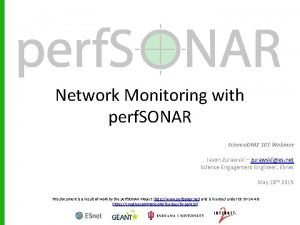High Performance Network Monitoring perf SONAR and its

- Slides: 1

High Performance Network Monitoring: perf. SONAR and its Uses Rebecca Purser, Joseph Lannamann, Brandon Finnerty Project Description Perf. SONAR, a network monitoring tool early in its life cycle, has excellent application for large organizations, specifically universities. We examined various use cases for perf. SONAR and created hands-on lab manuals for teaching others the functions of the program. The labs are conducted through NDG’s NETLAB+ virtual environment. The series of labs focuses on training users to configure performance tests, understand use metrics tools, and manage multiple nodes. Specific Client Needs • Ability to explain different recommendations based on perf. SONAR data • Sufficient number of completed labs • Each lab objective should be achieved within the contents of each lab, to do this, we must have an understanding of perf. SONAR and how it can be used to achieve the lab goal Integrated Information Technology Department ITEC 564 IT Capstone Projects Spring 2019 Technologies Used • perf. SONAR - Collection of open source software for performing and sharing end-to-end network measurments • TCP Tuning - Adjusting the default send/receive buffer size for all connection types in the /etc/sysctl. conf file as a way of network performance debugging • JSON Limit Scripting - Editing the /usr/share/doc/pscheduler/limit-examples file to configure throughput time between nodes • VMWare - A program that allows users to install different operating systems within a virtual environment Different Lab Sections Product Development & Deliverables Project Mission Statement The mission of this project is to develop training labs for perf. SONAR. This software is used in thousands of networks in order to test the performance and improve efficiency on them. Although it is widely used, there is a lack of hands-on training that teaches the system. By the end of the semester, we will create 3 hands-on labs that other organizations can use to train people to use perf. SONAR. PMBOK Project Processes Used During this project, we developed a project charter, defined tasks, and allocated resources to each task. We defined a communication plan with the client and project team and kept a communication log. We created a risk management plan and defined how to mitigate each level of risk. Project Results • First deliverable – We were able to draw out a topology recommendation and label each node with a size and package option • Second deliverable – A list of labs (shown) was presented along with notes and a link to the perf. SONAR documentation. Then our first drafts included the lab goal and objective • Final deliverable – The final labs we presented included proper formatting, accurate calculations and commands, and are fully intended to go on NETLAB+ Project Budget Future Recommendations - Anticipated (Time) Budget – 150 hours (50 hours per team member) - Actual Project (Time) Budget: 200 hours (about 66. 67 hours per team member) In the future, we recommend this project be apart of the two-semester section of Project Management for Information Technology. Since there is a learning curve with the technology, it would be more efficient to have one team for a whole year. Lessons Learned “The big lesson we learned was that the beginning stages of a project are very important. By taking the extra time to understand the project and clearly define a scope, there will be less confusion and fewer risks down the line. ” - Rebecca Purser, Joseph Lannamann, Brandon Finnerty 1. Topology Recommendation for NETLAB+ • Determine minimum hard drive requirement for download (Install VMWare on our personal machines and install perf. SONAR at different levels) • Determine what packages were necessary for each node and identify each package capability 2. List of Labs and First Draft of 2 Labs • Read release notes and software documentation to determine what topics were most important • Decide the goal of the lab then research the components and commands to be used 3. Three Completed Labs • Verbalize the purpose of each step and how it contributes to the overall goal of the lab • Conduct peer review of the labs to ensure accuracy and consistency in format. Key Stakeholders q Dr. Jorge Crichigno: jcrichigno@cec. sc. edu q José Gomez Gaona: gomezgaj@email. sc. edu q Elie Kfoury: ekfoury@email. sc. edu q National Labs, Berkeley Research Group

